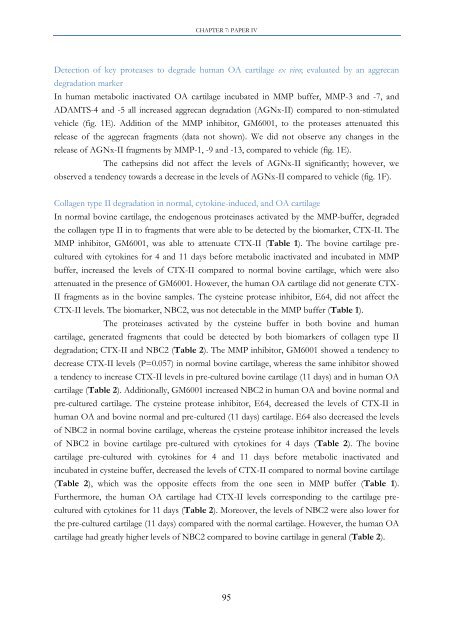Identification of important interactions between subchondral bone ...
Identification of important interactions between subchondral bone ...
Identification of important interactions between subchondral bone ...
You also want an ePaper? Increase the reach of your titles
YUMPU automatically turns print PDFs into web optimized ePapers that Google loves.
CHAPTER 7: PAPER IV<br />
Detection <strong>of</strong> key proteases to degrade human OA cartilage ex vivo; evaluated by an aggrecan<br />
degradation marker<br />
In human metabolic inactivated OA cartilage incubated in MMP buffer, MMP-3 and -7, and<br />
ADAMTS-4 and -5 all increased aggrecan degradation (AGNx-II) compared to non-stimulated<br />
vehicle (fig. 1E). Addition <strong>of</strong> the MMP inhibitor, GM6001, to the proteases attenuated this<br />
release <strong>of</strong> the aggrecan fragments (data not shown). We did not observe any changes in the<br />
release <strong>of</strong> AGNx-II fragments by MMP-1, -9 and -13, compared to vehicle (fig. 1E).<br />
The cathepsins did not affect the levels <strong>of</strong> AGNx-II significantly; however, we<br />
observed a tendency towards a decrease in the levels <strong>of</strong> AGNx-II compared to vehicle (fig. 1F).<br />
Collagen type II degradation in normal, cytokine-induced, and OA cartilage<br />
In normal bovine cartilage, the endogenous proteinases activated by the MMP-buffer, degraded<br />
the collagen type II in to fragments that were able to be detected by the biomarker, CTX-II. The<br />
MMP inhibitor, GM6001, was able to attenuate CTX-II (Table 1). The bovine cartilage pre-<br />
cultured with cytokines for 4 and 11 days before metabolic inactivated and incubated in MMP<br />
buffer, increased the levels <strong>of</strong> CTX-II compared to normal bovine cartilage, which were also<br />
attenuated in the presence <strong>of</strong> GM6001. However, the human OA cartilage did not generate CTX-<br />
II fragments as in the bovine samples. The cysteine protease inhibitor, E64, did not affect the<br />
CTX-II levels. The biomarker, NBC2, was not detectable in the MMP buffer (Table 1).<br />
The proteinases activated by the cysteine buffer in both bovine and human<br />
cartilage, generated fragments that could be detected by both biomarkers <strong>of</strong> collagen type II<br />
degradation; CTX-II and NBC2 (Table 2). The MMP inhibitor, GM6001 showed a tendency to<br />
decrease CTX-II levels (P=0.057) in normal bovine cartilage, whereas the same inhibitor showed<br />
a tendency to increase CTX-II levels in pre-cultured bovine cartilage (11 days) and in human OA<br />
cartilage (Table 2). Additionally, GM6001 increased NBC2 in human OA and bovine normal and<br />
pre-cultured cartilage. The cysteine protease inhibitor, E64, decreased the levels <strong>of</strong> CTX-II in<br />
human OA and bovine normal and pre-cultured (11 days) cartilage. E64 also decreased the levels<br />
<strong>of</strong> NBC2 in normal bovine cartilage, whereas the cysteine protease inhibitor increased the levels<br />
<strong>of</strong> NBC2 in bovine cartilage pre-cultured with cytokines for 4 days (Table 2). The bovine<br />
cartilage pre-cultured with cytokines for 4 and 11 days before metabolic inactivated and<br />
incubated in cysteine buffer, decreased the levels <strong>of</strong> CTX-II compared to normal bovine cartilage<br />
(Table 2), which was the opposite effects from the one seen in MMP buffer (Table 1).<br />
Furthermore, the human OA cartilage had CTX-II levels corresponding to the cartilage pre-<br />
cultured with cytokines for 11 days (Table 2). Moreover, the levels <strong>of</strong> NBC2 were also lower for<br />
the pre-cultured cartilage (11 days) compared with the normal cartilage. However, the human OA<br />
cartilage had greatly higher levels <strong>of</strong> NBC2 compared to bovine cartilage in general (Table 2).<br />
95

















